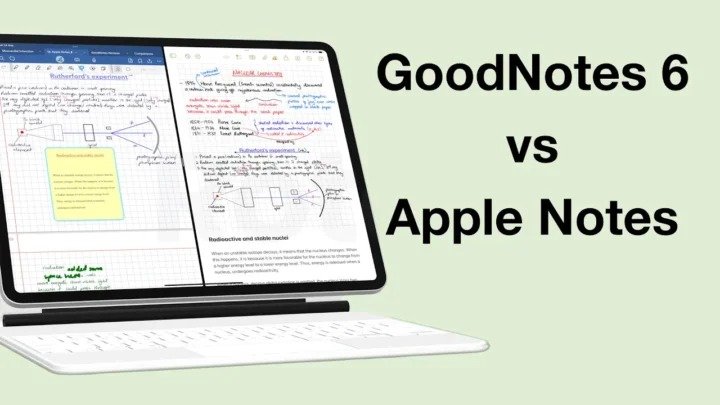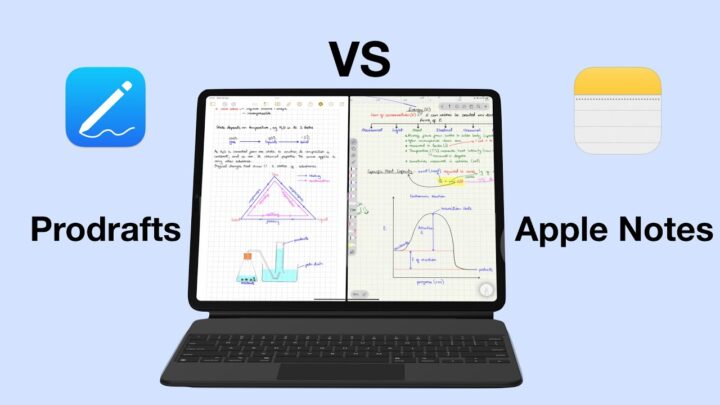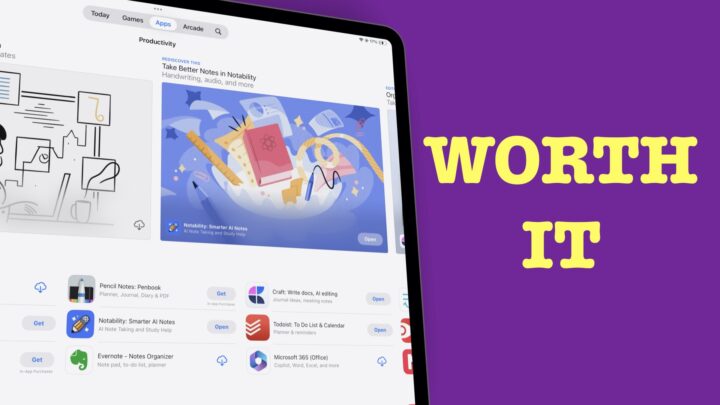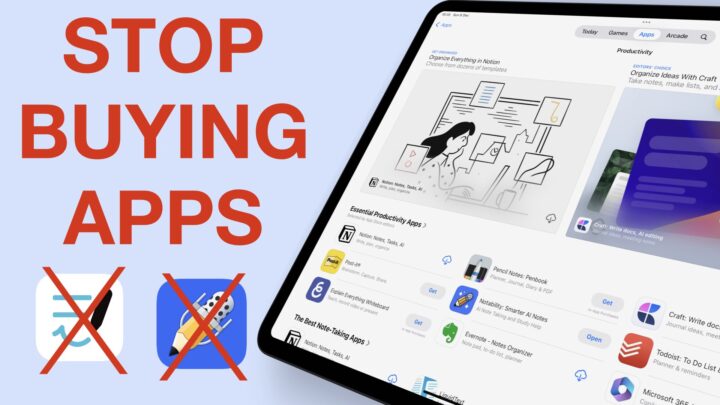A lot of you guys have been wondering if I still recommend Noteful as a Goodnotes replacement. I can’t answer that question unless we look at the apps side-by-side. I have divided this into 3 parts covering different aspects of the apps. That way, we cover everything systematically. This first part will cover the basics of the two apps.
Pricing
Noteful is the cheaper of the two apps, for $5 a one-time purchase. The app is limited to your Apple devices and only to M-series MacBooks, though. Goodnotes works on any MacBook because it has a dedicated macOS version. If you want to stay in the Apple ecosystem, the app costs $24-$30 for a one-time purchase. That depends on whether or not you qualify for a discount. But, to use Goodnotes on Android and Windows as well, you will need a subscription of $10/year. However you look at it, Noteful is the cheaper app.
New Notebooks
For creating new notebooks, both apps do a pretty good job. You get notebook covers, and if you’re anything like me, you’ll probably turn them off. You have a decent variety of page templates on both, but they are easier to navigate in Noteful. The app displays all of them on a single page, unlike in Goodnotes. Both apps give you colour options for your notebooks. Goodnotes colours are restricted to a single page template, though. I have different colours for this template, and even this one. Customising your page colours can be exhausting in Goodnotes if you use different page templates. Noteful’s page colours are centralised, and this is the setup I prefer. It’s a lot easier to work with. Which of these setups is best for your workflow? In both apps, you can choose a background and line colour in your templates.
They have pretty much the same page sizes, with a few differences. Noteful focuses on presentation pages. So, you get 16:9 and 4:3 page sizes. Goodnotes lets you customise your page sizes in points. The biggest page you can create in Goodnotes is 1.8m. The smallest is 7cm, that’s about the size of a business card. You can create everything in between. If you need that much flexibility on page sizes, Goodnotes is the clear winner. 0.07 to 1.8m is an insane range for paper size, and we haven’t seen that in any other handwriting note-taking app.
I don’t use native paper templates in my notes. I prefer our digital notebooks. And this will also be important if you use digital planners as well. For custom page templates, Noteful lets you save complete PDFs that you can organise into different categories. This is unique to Noteful on the iPad. Goodnotes only saves one page for custom templates, and that means I have to import my digital notebooks every time I need a new notebook in Goodnotes. It is a lot of work for something you need to do often.
User Interface
Goodnotes’ two toolbars have always looked clustered, and they still do even when you move the toolbar in Noteful to the top. In Noteful, your toolbar can go to any side of the screen, but in Goodnotes, it can only be at the top or bottom. Both apps can customise your toolbar, but it’s a lot easier to do in Noteful than in Goodnotes. In Noteful, it’s a simple switch that you turn on or off. Removing items from your toolbar is more work in Goodnotes, but at least adding is much simpler. Noteful also has an option to change the toolbar colour, which can either be light or dark. Goodnotes does not have that option.
Though I prefer the setup in Noteful, chances are, you’re only going to do this once. That said, it wouldn’t make you choose one app over the other. What matters is that you can customise your toolbar if you want to. Do you ever choose apps based solely on how it looks?
Pen tool
I have used both apps extensively over the last couple of years, and in both apps, I have set up the pen tools the best I can, according to my preferences within the capabilities of each. All the different pen types are better in Noteful than in Goodnotes. They feel and look better, and since handwriting is one of the main features I consider when choosing a handwriting note-taking app, I’ll go with Noteful on this one. Both apps have a ballpoint, fountain, and brush pen. But Noteful has more customisation options that create unique pens with a wide range of characteristics. Against Noteful, Goodnotes’ customisation, feels a bit inadequate. The app has a calligraphy pen, which Noteful does not have.
Your pen thickness options are easier to access in Goodnotes than they are in Noteful. Even though you’re only limited to just three thicknesses, you can easily access them on the toolbar in Goodnotes but in Noteful, that is a two-step process. The app has five fixed size, though. Few steps are always better. Noteful has a wider range for your pen thicknesses, though. It goes all the way up to 5mm, where Goodnotes only gets to a maximum of 2mm. If you’re using Goodnotes, have you ever felt like you need a pen thicker than 2mm?
For your colour, both apps do a good job and give you a variety on your toolbar as well as picking them to choose custom ones. You also get dotted and dash pens in both the apps, but Goodnotes has made them easier to access. So if you really use them, you’ll probably prefer the set up in Goodnotes it’s a lot more straightforward.
Highlighter and Pencil
Both highlighters are pretty good. They go behind your ink so they don’t dim your notes when you lay them. The setup in the two apps is really the same, and you can have a freehand or straight highlighter. A new update has been rolled out, introducing a pencil tool in Goodnotes. As is to be expected, it feels great. Pencils tend to write better than pen tools. It has similar options to the ones you get for your pen.
Eraser
Goodnotes has a smoother pixel eraser. It also has a standard eraser, which works like the one in Noteful, and a stroke one. Noteful’s pixel eraser is not very smooth, and it also has a stroke eraser. Both apps are selective for the highlighter, and they support auto-deselect. While Noteful has five fixed sizes for eraser, Goodnotes has only has three, but that doesn’t matter, though, as long as you can erase mistakes in your notes.
Zoom Tool
Noteful has the most impressive zoom range for handwriting note-taking app on the iPad. Thanks to a recent update, we now know what that range is because the app now displays your zoom level on the screen; 20-20000%. If that is not impressive, I don’t know what is. Goodnotes doesn’t display your zoom percentage on the screen, and it also doesn’t have an impressive range. You can also lock your zoom level in Noteful, which also locks it for the zoom tool.
Auto-advance in Noteful is easy to follow and understand, especially when moving between lines. You won’t lose track of where you are on your page. In Goodnotes, that’s certainly not the case. The zoom tool takes some getting used to, and it’s terrible when moving between lines. You have to heavily rely on moving it manually or customising it. Even that is not easy. Both apps support margins. Noteful’s zoom tool is perfect out of the box, and doesn’t need additional work from your part. This will probably make more sense to new Goodnotes users that old ones, though. If you have been using Goodnotes for a while, you probably understand the zoom tool by now.
Noteful also has two unique features for the zoom tool that you will not find anywhere else in 2024. It supports left-hand mode, where the zoom section goes to the top of your screen. It also supports right-to-left writing. Both those features, Goodnotes does not have. In fact, no other handwriting note-taking app does.
Favourites Toolbar
Another feature that you don’t get in Goodnotes is the favourites toolbar. Let’s hope that we’ll get it soon, seeing as we can customise our toolbars now. It’s usually a precursor to the feature. Noteful does have a favourite toolbar, but it is mixed with your colour palette and that can be confusing at first. It is still better than not having a favourites toolbar at all, but I am not sure it will make you choose Noteful over Goodnotes.
Final Thoughts
It’s still early to say, but Noteful so far has ticked more boxes than Goodnotes. We’ve only just scratched the surface, though. While these are core features of a handwriting note-taking app, there’s more to digital notes than handwriting, right? How do you feel about these two apps so far? Which app are you leaning towards? Do tell!





